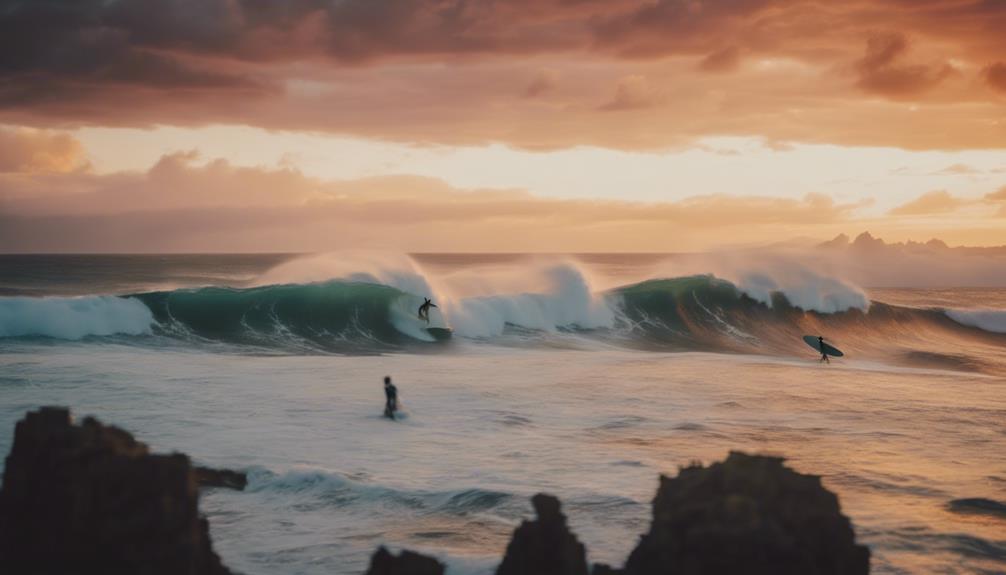Surfing wave pools use cutting-edge technology to simulate ocean waves, giving you an exciting surf experience. They generate waves through various methods like hydrofoils, piston-powered paddles, and air blasts. The pool's design, often with a slanted structure, enhances wave size and strength. You'll find large filtration systems keep the water clean, while advanced water management guarantees a constant flow. Lifeguards oversee safety, and energy-efficient practices help protect the environment. Whether you're a beginner or an expert, wave pools offer customizable conditions. Stick around to uncover the technical wonders behind your next surfing adventure!
Key Takeaways
- Wave pools utilize advanced technologies like hydrofoils and piston-powered paddles to create artificial waves suitable for various skill levels.
- Wave generation mechanisms include air blasts and hydraulic systems, allowing for precise control over wave size and frequency.
- The design features slanted structures and varying bottom contours to enhance wave strength and create diverse surfing conditions.
- Water management systems recycle and maintain water quality through sophisticated filtration and disinfection methods, ensuring cleanliness and safety.
Overview of Wave Pool Technology
Wave pools use advanced technologies like hydrofoils, piston-powered paddles, and pressurized air systems to create ocean-like waves in a controlled setting. These innovations enable the generation of artificial waves that mimic natural surf conditions, ensuring an exhilarating surfing experience.
Hydrofoil technology, for instance, employs submerged foils that displace water, producing long, bi-directional waves. This method can deliver high-quality surfable waves, perfect for surfers of all skill levels.
In addition to hydrofoils, wave generation methods like piston-powered paddles and pressurized air systems provide customizable wave sizes and frequencies. These systems allow you to adjust the intensity and shape of the waves, catering to both beginners and advanced surfers.
The unique designs of wave pools, including tailored bottom contours and gutter systems, enhance wave quality while managing turbulent whitewater, making for a more authentic surfing experience.
With options to control wave parameters, you can enjoy a variety of surfing conditions in a single session. Whether you're looking to catch small, gentle waves or challenge yourself with larger swells, wave pools offer an innovative solution for surf enthusiasts seeking consistent and enjoyable conditions.
Wave Generation Mechanisms

In surfing wave pools, various mechanisms like air blasts, paddle wheels, and oscillating plungers create disturbances in the water that effectively mimic the natural waves found in the ocean. These wave generation methods can produce surfable waves suited for different skill levels.
For instance, a high-speed fan can blow pressurized air into a metal pipe, where a hydraulic piston controls a butterfly valve to create controlled bursts of air, generating the desired wave system.
Larger wave pools often utilize water surges instead of air blasts. They rely on a sophisticated water-pumping system and a collection reservoir to manage wave creation effectively. In this process, pressurized oil directs to a hydraulic cylinder that moves a piston, releasing water from a reservoir through a curved passageway, thereby forming waves.
Advanced technologies play an essential role in wave generation, allowing for precise manipulation of wave characteristics. This means you can enjoy consistent wave formations tailored to your preferences, enhancing your surfing experience.
Whether you're a beginner or an expert, these innovative mechanisms guarantee that every ride is exciting and challenging.
Wave Pool Design and Components

Designing a wave pool involves creating a slanted structure that enhances wave size and strength while incorporating a return canal for efficient water circulation. The wave pool design typically features a powerful wave generator, like those used in Thunder Bay, which utilizes multiple pumps to drive around 40,000 gallons of water per minute. This guarantees superior wave creation and management.
To achieve diverse surfing experiences, the bottom contour of the pool is meticulously designed, with slopes that vary to produce different wave sections. This careful bathymetry not only impacts wave quality but also affects the adrenaline rush of surfers.
Water circulation is maintained through large filtration systems, which play a vital role in safeguarding water quality. These systems continuously clean and filter the water, meeting safety standards and providing a clean environment for surfers.
Additionally, water reservoirs are designed with multiple chambers and individual release valves, allowing for precise control over wave generation.
Water Management Systems

Effective water management systems are essential for maintaining ideal conditions in wave pools, as they address challenges like evaporation and water quality.
You'll find that continuous water loss occurs through both evaporation and filtration, which means replenishing water from city lines or underground wells is critical to sustain optimal levels.
The wave pool relies on a reservoir, drawing water through a sophisticated pump system that circulates it, much like a toilet fills its tank. This circulation is essential not just for wave generation but also for ensuring a consistent flow of chlorinated water, keeping it clean and safe for surfers.
To manage water quality, the maintenance manager continuously monitors the pool's cleanliness, utilizing advanced filtration and disinfection systems. These systems work in tandem with multiple chambers and individual release valves, efficiently controlling water circulation and wave generation.
By investing in well installation initially, you can reduce monthly operational costs, promoting a sustainable water supply for both the wave pool and feeder pools.
Ultimately, a well-designed water management system is key to preserving the enjoyable experience of surfing in a man-made wave pool.
Environmental and Safety Considerations

As wave pools become more popular, addressing their environmental and safety considerations is essential for ensuring a sustainable and enjoyable experience for all visitors.
The environmental impact of wave pools is significant due to high energy consumption, making it imperative to utilize renewable energy sources to reduce their carbon footprint.
Water management is another key factor. Efficient systems must be in place to recycle water and minimize the strain on local water sources. This helps protect local ecosystems while maintaining the wave pool's operation.
Safety measures play an important role in ensuring a secure environment for participants. Lifeguards are essential in wave pools, providing a rapid response to emergencies and overseeing safety protocols.
To maintain water quality, stringent chemical management practices are necessary, including regular monitoring of chlorine levels and other disinfectants.
Frequently Asked Questions
How Do Surfing Wave Pools Work?
Surfing wave pools work by using technologies like hydrofoils or piston-powered paddles to generate waves. You'll enjoy a customizable surfing experience, with various wave sizes and types tailored to your skill level in a controlled environment.
How Does the Wave at the Surf Ranch Work?
At the Surf Ranch, you'll experience waves generated by a submerged hydrofoil that pushes water, creating a perfect soliton. The unique design and technology guarantee long, rideable waves for both left and right surfers.
How Does the Wavegarden Technology Work?
Wavegarden technology creates waves using piston-powered paddles that displace water. With adjustable sizes and frequencies, it caters to all skill levels, allowing you to enjoy consistent and customizable surfing experiences in a controlled environment.
How Are Waves Created in a Wave Pool?
Waves in a wave pool are created using various methods, like hydrofoils, piston paddles, or pressurized air systems. Each technique displaces water, generating surfable waves tailored to different skill levels and preferences.
How Do Surfing Wave Pools Compare to Natural Surfing Waves?
Surfing wave pools offer controlled, consistent waves, while natural surfing waves are unpredictable and influenced by weather conditions. The biggest surfing wave world can be found in both settings, with wave pools providing a more reliable experience for surfers, while natural waves offer a more challenging and thrilling ride.
Conclusion
In the grand scheme of aquatic escapades, wave pools offer a delightful twist on nature's surf.
You can ride the swells without having to brave the unpredictable ocean, enjoying a controlled environment that keeps safety in mind.
With innovative technology creating perfect waves, you're not just experiencing the thrill of surfing; you're embracing a marvel of engineering.
So, plunge into and relish the joy of catching waves, all while staying in the comfort of a man-made paradise.










